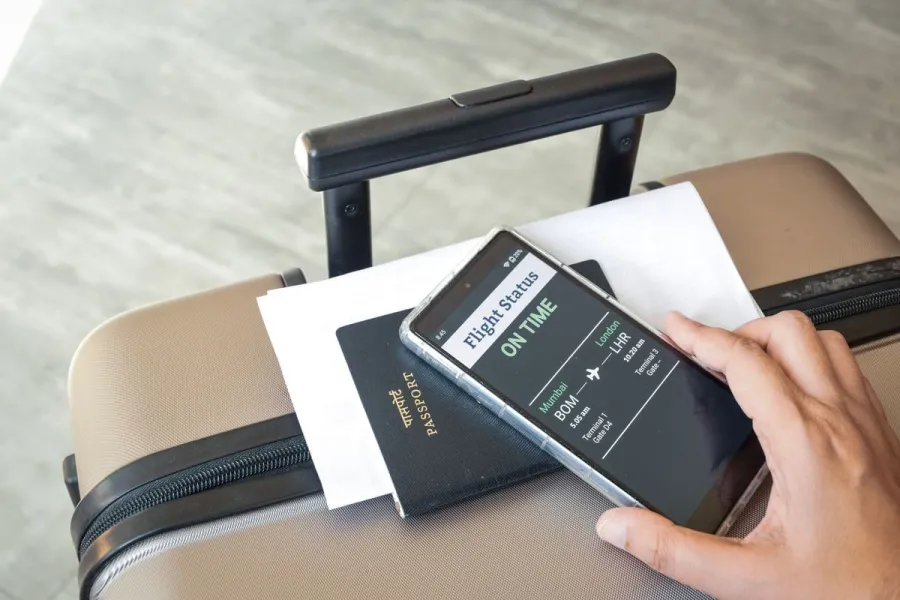Change language
Everything you need to know about tracking flight
May 23, 2025

Whether you're waiting for a loved one to land, keeping an eye on your own journey, or just curious about the planes above you, flight tracking puts real-time flight data at your fingertips. In this guide, you'll learn exactly how it works, why it’s useful, and how to get started — no tech skills required.
What Is a Flight Tracker and How Does It Work?
A flight tracker is a digital tool that allows you to monitor the real-time location, status, and movement of aircraft in the sky. Whether you're following a loved one’s journey, tracking your own upcoming flight, or just curious about the plane flying overhead, flight trackers give you a window into the world of aviation.
These tools work by collecting data from multiple sources, including:
- ADS-B signals: Most modern aircraft transmit their position, speed, and altitude via automatic signals.
- Radar and satellite systems: These help refine flight data, especially over oceans or remote areas.
- Airline and airport databases: Provide schedule information, delays, and gate changes.
All this information is combined and displayed on a live, interactive map. You can see the plane’s current position, flight number, departure and arrival airports, estimated arrival time, and sometimes even aircraft type or weather conditions. Many flight trackers are available online or through mobile apps — some free, others with premium features for deeper insights.
Besides travel planning and curiosity, flight trackers can also help you monitor potential delays or cancellations. If your flight gets canceled, knowing the status early allows you to act faster — and it may even support your claim for cancelled flight compensation, depending on the airline’s policy or passenger rights laws in your region.
What Can a Flight Tracker Show You?
A flight tracker gives you far more than just a plane’s location on a map — it offers a full picture of a flight’s journey in real time. Whether you're following a commercial flight or monitoring your own travel plans, here’s what you can typically expect to see:
Real-time flight location
See exactly where the aircraft is in the sky, updated live as it moves. Some trackers even show the aircraft's icon flying across a global map so you can follow its path in real time.
Flight status and delays
You’ll get updates on whether a flight is on time, delayed, diverted, or cancelled — often before it’s announced at the airport. This helps passengers or those picking someone up to stay informed early.
Route, path, and historical data
Trackers display the entire route from departure to arrival, including the projected flight path, actual deviation (if any), and current position along the journey.
Altitude, speed, and aircraft type
Many trackers show the plane’s altitude, ground speed, and typically even the aircraft type, model, and registration number.
Scheduled and actual times
You can view both scheduled and estimated times for takeoff and landing — a useful feature for coordinating airport pickups or connections.
Weather and airspace info
Some advanced trackers offer weather overlays or nearby air traffic visuals, so you can see conditions affecting the flight in real time.
Premium versions regularly include access to past flights, helping you see patterns, frequent delays, or the average arrival times for specific routes.
Why Tracking Flight Live Can Be Useful
Tracking a flight in real time isn’t just something aviation geeks enjoy — it’s a genuinely useful tool for everyday travelers, families, and even businesses. Whether you're flying yourself or waiting on someone else, knowing exactly where a plane is and how it’s progressing can save time, reduce stress, and help you make quicker decisions.
Here’s how live flight tracking comes in handy:
- For travelers: You can check if your flight is delayed, diverted, or arriving early — no more relying solely on airport monitors. It also helps you plan for gate changes, tight connections, or even delayed flight compensation claims when applicable.
- For those picking someone up: No more circling the airport parking lot or waiting unnecessarily — just track their flight and time your arrival perfectly.
- For travel disruptions: When weather, strikes, or mechanical issues arise, flight trackers often show status updates before they’re officially announced. That head start can help you rebook flights or arrange alternative plans faster.
- For peace of mind: Friends and family can follow your journey from home, watching your progress safely from takeoff to touchdown.
In short, tracking a flight live gives you control and clarity in an environment where uncertainty is common. It turns you from a passive passenger into an informed one — and that’s always a win when you’re dealing with airports.
How Does Flight Tracking Technology Work?
Flight tracking technology is a mix of aviation systems, satellite data, and real-time transmissions — all working together to show you where a plane is and what it’s doing in the sky. While it looks simple on your screen, the behind-the-scenes process is surprisingly advanced.
Most modern aircraft are equipped with a system called ADS-B (Automatic Dependent Surveillance–Broadcast). This technology sends out the aircraft’s position, altitude, speed, and direction every second using satellite GPS data. These signals are picked up by ground stations and satellites, then sent to tracking platforms where they appear as live updates on your device.
But that’s not the only source. Flight trackers also gather data from:
- Radar systems, especially in areas with high air traffic
- Airline databases for scheduled departures, gate info, and known delays
- Airport systems for real-time runway activity
- Weather satellites to overlay storms and turbulence
Ways You Can Start Tracking a Flight
Tracking a flight is easier than ever — whether you're at home, on the go, or already at the airport. You don’t need any technical skills to get started; just the right tools and a few details about the flight.
Here are a few simple ways to start tracking:
- Use a flight tracking website or app: Platforms like Flightradar24, FlightAware, or airline-specific apps let you search by flight number, route, or airport. Many offer live maps, status updates, and even 3D views of the aircraft’s position.
- Track directly through the airline: Most airlines provide real-time updates on their websites or apps. If you’ve booked a flight, you’ll often receive alerts about gate changes, boarding times, and estimated arrival.
- Airport monitors and kiosks: Once you're at the airport, you can check large digital boards or information desks for live updates. Still, using your phone to track flights gives you more flexibility — especially if you're wondering things like how early should you be at the airport to catch a connection or respond to a delay.
- Smart assistants and notifications: You can ask voice assistants (like Siri or Google Assistant) to track flights for you, or set up push notifications in mobile apps so you’re informed instantly if there’s a delay or gate change.
Information You’ll Need to Track a Flight Accurately
Tracking a flight in real time is quick and easy — but to get accurate results, you’ll need a few key details. The more specific you are, the faster you’ll find the correct flight, especially if multiple planes are flying similar routes.
Here’s what you should have on hand:
Flight number (e.g., LH123 or AA870)
This is the most direct and reliable way to track a flight. It’s unique and ties directly to the aircraft on that day. You’ll find it on your ticket, boarding pass, or airline confirmation email.
Airline name
Knowing whether you’re flying with Lufthansa, Qatar Airways, or Delta helps filter results — especially useful when codeshare flights are involved.
Departure and arrival airports
If you don’t have the flight number, you can search using the origin and destination (e.g., Paris to New York), but keep in mind that there may be multiple flights on the same route.
Date and time of the flight
Tracking tools usually list multiple flights by route, so adding the correct date and estimated departure time will help you avoid confusion.
Aircraft tail number or registration (optional)
If you're really into aviation, some trackers let you follow a specific plane using its registration (like “N123AB”) — great for private jets or cargo flights.
Continue to read: Flight check-in: what it means and what are the steps to do it!
Flight tracking isn’t just for aviation geeks or control tower staff — it’s for anyone who wants to fly smarter, wait less, and stay in the know. Now that you’ve got the tools, you can follow any flight like a pro — whether it’s cruising smoothly or caught in a bit of turbulence (literal or logistical).
✈️ Had a delayed or cancelled flight? Don’t let it slide. Get in touch with AirClaim and find out if you’re eligible for compensation — it’s fast, simple, and totally worth it.
More travel blog recommendations

Gjør ditt forsinkede, kansellerte eller overbookede fly om til en kompensasjon på opptil €600!
Kompensasjon for kansellert flyforsinkelse
Fly refusjon for kansellert flyforsinkelse
Flykompensasjon
©2025 AirClaim.com - Alle rettigheter forbeholdt Air Claim SA - Bdul. Pipera 1/Vi Bl. HYPERION TOWERS Et. 3 SP. BIR. 3 Cod 077190, Voluntari, Ilfov, Romania

















